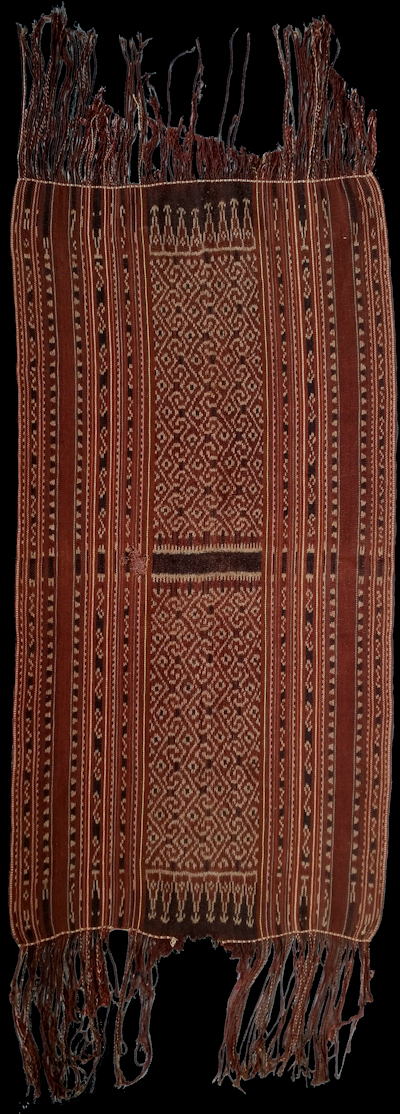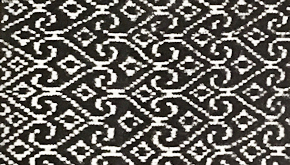| |
 
 | | | |
321 Solor Archipelago, Solor
Selendang (shawl)  
| | Locale: | Lewotanaole village in West Solor, Lamaholot people | | Period: | Late 19th to early 20th c. | | Yarn: | Cotton, hand-spun, medium, and silk pinstripes | | Technique: | Warp ikat | | Panels: | 1 | | Size: | 58 x 121 cm (1' 10" x 3' 11") LW: 2.09 | | Weight: | 350 g (12.3 oz), 499 g/m2 (1.64 oz/ft2) | | Design: | This tenapi, a very rare early example, looks patola-inspired, though the pattern of interlocking hooks on the midfield could not be traced to a known type. The tumpal finials of course are a clear sign of patola emulation, as are the strips of white triangles, also seen on the kamben cepuk of Bali, there called gigi Barong, 'teeth of Barong'. | | Comment: | Such tenapi were, and at ceremonies still are, worn by both men and women in western Solor, though nowadays they are nearly always made with chemical dyes. The condition is remarkably good its age. A small mouse hold on the axial fold has on old repair by means of darning, there is a tiny hole in one of the bordes, and at the bottom a short section of the edge has worn (or been eaten) away. The cloth still appears to have all of its original deep saturation of the morinda, and feel somewhat stiff but firm. The dark pink and the blue pinstripes, which appear dull under the microscope were done in cotton, the pink and yellow in, so bright under the micrscople's led-light that the light needed to dimmed, clearly were done in silk. | | Background: | Chapters on Solor Archipelago and Solor. | | Published: | Ikat from Timor and its Outer Islands, 2022.
| | Compare: | 221 | | Sources: | There is no Solor selendang in the otherwise quite comprehensive Ernst Vatter collection (collected in 1928/29) preserved at Frankfurt's Weltkulturen Museum, but, as Linda S. McIntosh pointed out, Vatter did photograph a sarong with similar , though not identical, patterning, and showed it in his Ata Kiwan, p.50 (see image below). Gittinger (who mysteriously calls Vatter a missionary) showed it in Splendid Symbols, FIg. 130. Although patola influence is suspected, also by Gittinger, no similar interlocking pattern was found in Bühler and Fischer, `The Patola of Gujarat. A sarong from Ili Api on Lembata in the Thomas Murray collection, depicted in Aragon et al., Indonesian Textiles, Fig. 6.14, and dated as 19th c., has the same patterning.
 | | |

©Peter ten Hoopen, 2025
All rights reserved.
|
|


